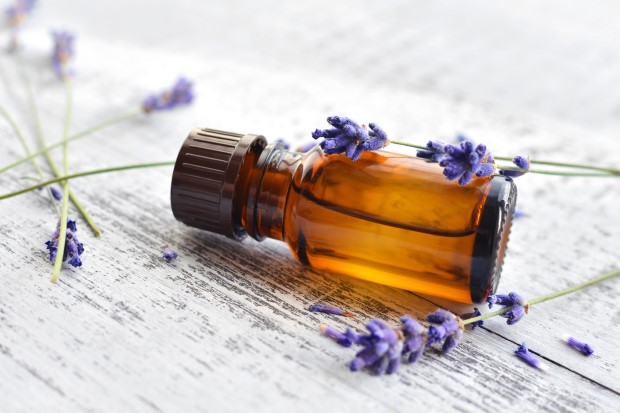
Soon after I moved to British Columbia, Canada, I went for a leisurely drive to a town about an hour away, down a winding, scenic lakeside road with stunning vineyards scattered across the countryside. As I neared the end of the road, the intensely fragrant scent of lavender filled my senses, long before I could even see the flowers. I drove down a side road and traveled about a half mile through the rolling hillside before finally spotting the source of the heavenly aroma: the stunning silvery-green and violet-colored plants at a lavender farm. I felt immediately transported to a peaceful, relaxed state. How much was linked to the actual aromatic effects of lavender or the natural beauty of it in this lovely environment, I’ll never know. Either way, it was an experience that I won’t forget.
Lavender (Lavandula angustifolia) has been in use for at least 2,500 years, including for mummification and perfumery by the ancient Egyptians, Phoenicians, and Arabs. The flowers were infused in water in Roman baths, which led to the modern name for lavender (from the Latin lavare, which means “to wash”). Ancient Romans are also believed to have used lavender for cooking and for scenting the air. In ancient Rome, lavender flowers were so highly prized that a single pound was sold for the equivalent of a month of a farm worker’s wages.1 During the height of the Plague, glove makers scented their leatherware with lavender oil, which was believed to ward off the deadly infection.2
The oil extract of the delicate, lovely flowers of lavender provides a potent natural remedy that, while not specifically a pain remedy, can help address hormonal imbalances during a woman’s menstrual cycle. A study published in the journal BioPsychoSocial Medicine found that inhaling the scent of lavender for ten minutes had a significant beneficial effect on the nervous system of women suffering from premenstrual symptoms and could decrease feelings of depression.3 While the study focused on emotional pain, the hormonal imbalances that occur during a woman’s period can also result in painful cramping.
Considering that chronic pain can result in depression, anxiety, or difficulty sleeping, not only for women during their menstrual periods but for anyone dealing with chronic pain, lavender can help address all of these issues.
In a study published in the medical journal Complementary Therapies in Clinical Practice, researchers found that when women inhaled two drops of lavender essential oil at three intervals during labor, they experienced a significant reduction in labor pain.4
Lavender’s ability to affect the nervous system suggests it may also offer hope for those suffering from nerve pain linked to various pain conditions. In an animal study published in the medical journal Frontiers in Pharmacology, researchers found that lavender essential oil was effective in reducing neuropathy pain.5 A recent study in the Journal of Neuroimmunology corroborated the earlier study, finding that lavender essential oil was effective in reducing chronic inflammation and neuropathy pain.6
Lavender essential oil is also showing promise in preliminary studies of its use for osteoarthritis pain. In research published in Complementary Therapies in Clinical Practice, scientists applied lavender essential oil to affected knees of study participants. The study found that the results were best both immediately and one week after continued use, but then tapered off.7 More research needs to be conducted to determine the short- and long-term results of topically applied lavender essential oil for the management of painful osteoarthritic joints, but based on lavender’s impressive safety record, it is worth considering for those suffering from osteoarthritis.
Lavender essential oil has traditionally been used to speed the healing and ease the pain of burns and wounds of all kinds, including those involving sunburn, fire, or scalding. The efficacy of these traditional uses have been verified by extensive research, including a study in the journal Complementary Therapies in Clinical Practice that showed that lavender essential oil reduced the recovery time needed after episiotomies linked to childbirth.8 Additionally, research published in the journal Phytotherapy Research found that scientific and clinical data support the traditional uses of lavender essential oil.9
If you’re suffering from hormone-related pain, nerve pain, or burns of any kind, it is worth considering lavender for your pain management protocol.
How to Use:
Lavender essential oil can be diffused in an aromatherapy diffuser, applied topically, or used internally. In my experience, while diffusing lavender essential oil works well to relax the nervous system, ease stress, and alleviate anxiety and depression, the best way to experience lavender’s analgesic effects is to apply it topically to painful areas and deeply inhale the aroma at least a few times daily. Obviously, that’s not possible for all types of pain, so diffusing may be a good option for some conditions.
Safety Considerations:
Purchase lavender essential oil that is extracted from the lavender species Lavandula angustifolia. Most of the lavender oils on the market are made from cheaper varieties that do not yield the same therapeutic results. If you’ve selected pure, high-quality, therapeutic-grade lavender essential oil, it is likely safe to apply undiluted (neat) directly to your skin, unless you have highly sensitive skin. If you have sensitive skin, dilute one drop of lavender with five drops of a carrier oil like fractionated coconut or apricot kernel oil before applying. It is best to conduct a forty-eight-hour skin patch test on the inside of your wrist before applying to a more widespread area.



